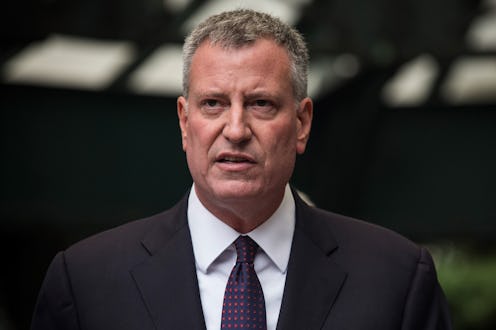News
Traditionally, Has Police Reform Worked?
The national debate on police brutality is reaching fever pitch. It's the first time in more than 20 years, if not ever, that the state of law enforcement has been under such scrutiny. On Thursday, New York City Mayor Bill de Blasio announced retraining plans for the NYPD in response to the death of unarmed black man Eric Garner, who was killed after officer Pantaleo put him in a choke hold. While the discourse might be reaching deafening levels, it certainly isn't the first time that such police reforms were enforced in addressing nation-shaking cases of police brutality.
One day after the grand jury decided not to indict Pantaleo in Garner's death, Mayor de Blasio announced the start of a department-wide retraining program, saying at a press conference, "The way we go about policing has to change." The mayor also addressed the unavoidable racial factor in these cases.
People need to know that black lives and brown lives matter as much as white lives.
Though de Blasio didn't go into detail about the reform program, NYPD Commissioner Bill Bratton said that retraining would take place over three days and is modeled after the firearms retraining that all officers are required to have. First Deputy Benjamin Tucker then gave a general outline of the "de-escalation" lessons, which will teach officers to handle street encounters with a "nonjudgmental" approach.
Mayor de Blasio has long supported reforming NYPD practices since before he even took office, and once he did he made good on his promise by tackling stop-and-frisk. And earlier this month, the NYPD began its pilot program for officers to wear body cameras, which might set an effective example for the rest of the country.
But how do all these changes in New York compare to department overhauls in the past, provoked by similar incidents?
Rodney King
The biggest insurrection since the Civil Rights movement of the '60s, the LA Riots erupted after the officers involved in the Rodney King beating were acquitted in 1992. Like the Garner case, the LAPD officers were clearly caught on video beating King repeatedly. It was a scene that feels all too familiar today — the city, outraged over the decision, rioted, looted, and caused major civil disturbance over a six-day period before the California Army National Guard was brought in to control the unrest.
Following the beating in 1991, the LAPD attempted to implement reform, known as the Christopher Commission, which sought to conduct "a full and fair examination of the structure and operation" of the department's training, citizen complaint system, and internal disciplinary system. The investigation found that a significant number of LAPD officers use excessive force with many repeat offenders, and that the department's management of these officers was the root of the problem.
The most effective change that came out of the Christopher Commission was the end of lifetime terms for officers, following the resigning of Police Chief Daryl Gates, who had overseen increased militarization in the LAPD during his tenure. In 1994, Congress passed some provisions to the Crime Control Act, which enabled the Department of Justice to bring civil suits against local police departments who had a pattern of using excessive force. This was a game-changer in police accountability.
Amadou Diallo
On February 4, 1999, unarmed Amadou Diallo was shot and killed by four NYPD officers, who fired a combined total of 41 shots. All four officers were charged with second-degree murder but later acquitted.
Then Commissioner Howard Safir implemented some immediate changes, like adding more minority members to the Street Crimes unit, whose officers had shot Diallo. The public and activists saw this as nothing more than a PR move and the Center for Constitutional Rights filed a class action suit against the overuse of stop-and-frisk. The case findings, which were not released until after Sean Bell's shooting in 2006, led a federal judge to rule that the NYPD was guilty of unconstitutional racial profiling. New legislation followed that further held police accountable, including the assignment of an inspector general and the ability for citizens to sue the police department for racial, sexual, and religious profiling.
Timothy Thomas
In 2001, a Cincinnati police officer chased unarmed 19-year-old Timothy Thomas outside a nightclub and opened fire, killing him. The racially charged shooting sparked four nights of rioting in the Ohio city, which was already plagued with existent tension between law enforcement and the community. Thomas was the 15th black man in six years who died after a police altercation.
As a result of the public outrage and federal intervention, Cincinnati law enforcement started cooperating on a settlement that stemmed from a suit from before the shooting. In the Collaborative Agreement, officers were given Tasers and trained to use less-lethal force in general. Police cars were equipped with dash cameras and the department also became more involved with the community, holding meetings and responding directly to their complaints. A Citizen Police Review Board was also formed to as a further accountability measure.Images: Getty Images (3)
